Fuel OPEL VIVARO C 2020.25 Manual user
[x] Cancel search | Manufacturer: OPEL, Model Year: 2020.25, Model line: VIVARO C, Model: OPEL VIVARO C 2020.25Pages: 287, PDF Size: 28.79 MB
Page 27 of 287
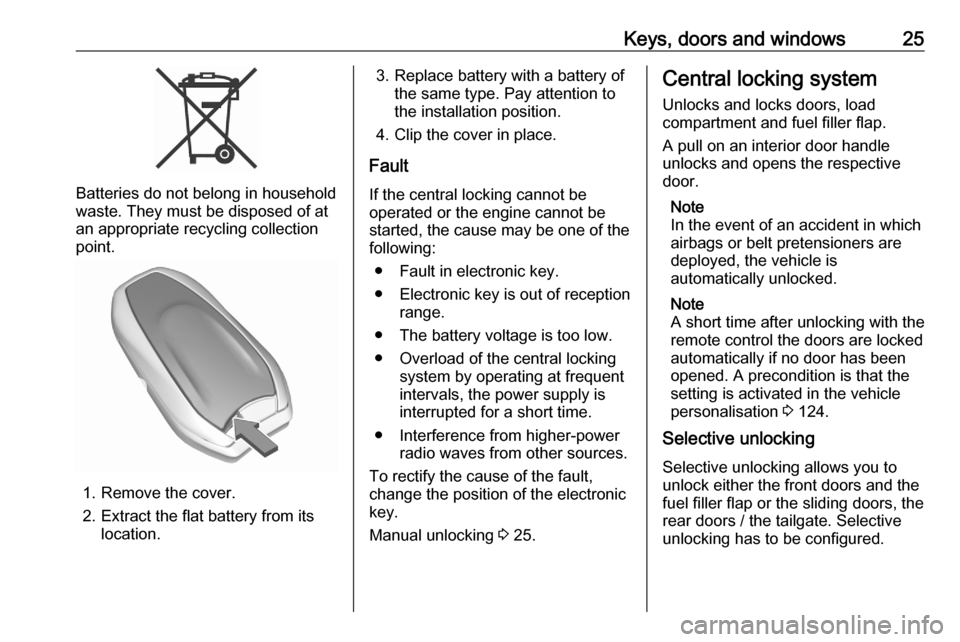
Keys, doors and windows25
Batteries do not belong in household
waste. They must be disposed of at
an appropriate recycling collection
point.
1. Remove the cover.
2. Extract the flat battery from its location.
3. Replace battery with a battery ofthe same type. Pay attention to
the installation position.
4. Clip the cover in place.
Fault
If the central locking cannot be
operated or the engine cannot be
started, the cause may be one of the
following:
● Fault in electronic key.
● Electronic key is out of reception range.
● The battery voltage is too low. ● Overload of the central locking system by operating at frequent
intervals, the power supply is
interrupted for a short time.
● Interference from higher-power radio waves from other sources.
To rectify the cause of the fault,
change the position of the electronic
key.
Manual unlocking 3 25.Central locking system
Unlocks and locks doors, load
compartment and fuel filler flap.
A pull on an interior door handle
unlocks and opens the respective
door.
Note
In the event of an accident in which
airbags or belt pretensioners are
deployed, the vehicle is
automatically unlocked.
Note
A short time after unlocking with the
remote control the doors are locked
automatically if no door has been
opened. A precondition is that the
setting is activated in the vehicle
personalisation 3 124.
Selective unlocking
Selective unlocking allows you to
unlock either the front doors and the
fuel filler flap or the sliding doors, the
rear doors / the tailgate. Selective
unlocking has to be configured.
Page 29 of 287
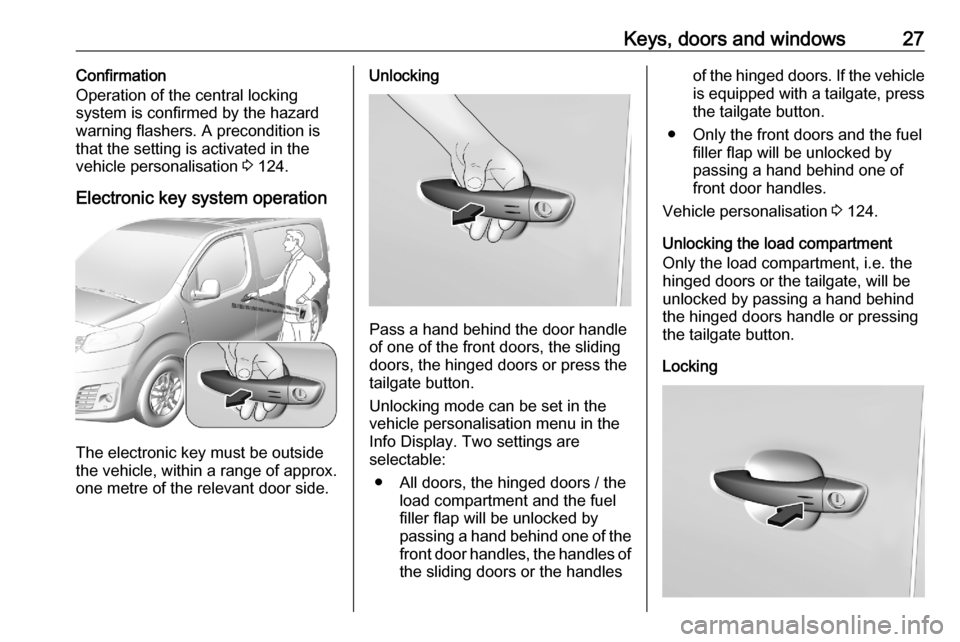
Keys, doors and windows27Confirmation
Operation of the central locking
system is confirmed by the hazard
warning flashers. A precondition is that the setting is activated in thevehicle personalisation 3 124.
Electronic key system operation
The electronic key must be outside
the vehicle, within a range of approx. one metre of the relevant door side.
Unlocking
Pass a hand behind the door handle
of one of the front doors, the sliding
doors, the hinged doors or press the
tailgate button.
Unlocking mode can be set in the
vehicle personalisation menu in the
Info Display. Two settings are
selectable:
● All doors, the hinged doors / the load compartment and the fuel
filler flap will be unlocked by
passing a hand behind one of the front door handles, the handles of
the sliding doors or the handles
of the hinged doors. If the vehicle is equipped with a tailgate, press
the tailgate button.
● Only the front doors and the fuel filler flap will be unlocked by
passing a hand behind one of
front door handles.
Vehicle personalisation 3 124.
Unlocking the load compartment
Only the load compartment, i.e. the
hinged doors or the tailgate, will be
unlocked by passing a hand behind
the hinged doors handle or pressing
the tailgate button.
Locking
Page 30 of 287
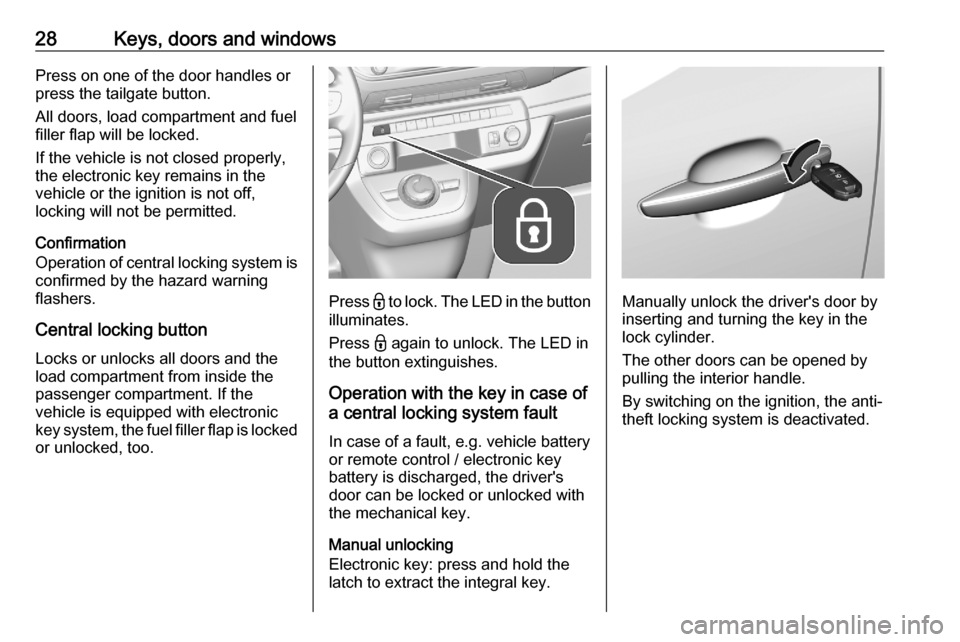
28Keys, doors and windowsPress on one of the door handles or
press the tailgate button.
All doors, load compartment and fuel
filler flap will be locked.
If the vehicle is not closed properly,
the electronic key remains in the
vehicle or the ignition is not off,
locking will not be permitted.
Confirmation
Operation of central locking system is confirmed by the hazard warning
flashers.
Central locking button
Locks or unlocks all doors and the
load compartment from inside the
passenger compartment. If the
vehicle is equipped with electronic
key system, the fuel filler flap is locked or unlocked, too.
Press - to lock. The LED in the button
illuminates.
Press - again to unlock. The LED in
the button extinguishes.
Operation with the key in case of
a central locking system fault
In case of a fault, e.g. vehicle battery
or remote control / electronic key
battery is discharged, the driver's
door can be locked or unlocked with
the mechanical key.
Manual unlocking
Electronic key: press and hold the
latch to extract the integral key.Manually unlock the driver's door by
inserting and turning the key in the
lock cylinder.
The other doors can be opened by
pulling the interior handle.
By switching on the ignition, the anti- theft locking system is deactivated.
Page 31 of 287
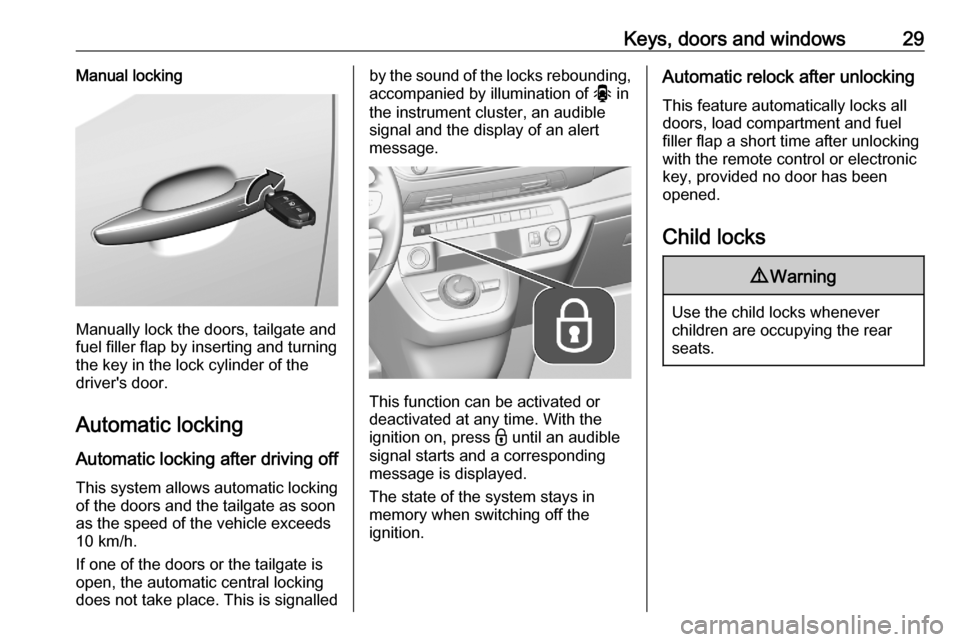
Keys, doors and windows29Manual locking
Manually lock the doors, tailgate and
fuel filler flap by inserting and turning the key in the lock cylinder of the
driver's door.
Automatic locking Automatic locking after driving off
This system allows automatic locking of the doors and the tailgate as soon
as the speed of the vehicle exceeds
10 km/h.
If one of the doors or the tailgate is open, the automatic central locking
does not take place. This is signalled
by the sound of the locks rebounding, accompanied by illumination of N in
the instrument cluster, an audible signal and the display of an alert
message.
This function can be activated or
deactivated at any time. With the
ignition on, press - until an audible
signal starts and a corresponding
message is displayed.
The state of the system stays in
memory when switching off the
ignition.
Automatic relock after unlocking
This feature automatically locks all
doors, load compartment and fuel
filler flap a short time after unlocking
with the remote control or electronic
key, provided no door has been
opened.
Child locks9 Warning
Use the child locks whenever
children are occupying the rear
seats.
Page 34 of 287
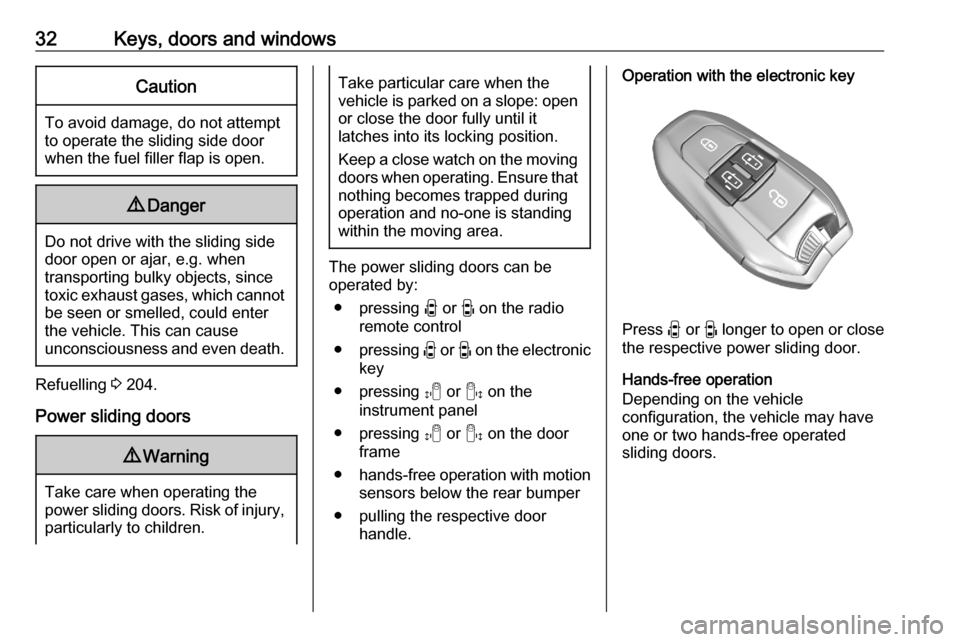
32Keys, doors and windowsCaution
To avoid damage, do not attempt
to operate the sliding side door
when the fuel filler flap is open.
9 Danger
Do not drive with the sliding side
door open or ajar, e.g. when
transporting bulky objects, since
toxic exhaust gases, which cannot be seen or smelled, could enter
the vehicle. This can cause
unconsciousness and even death.
Refuelling 3 204.
Power sliding doors
9 Warning
Take care when operating the
power sliding doors. Risk of injury, particularly to children.
Take particular care when the
vehicle is parked on a slope: open
or close the door fully until it
latches into its locking position.
Keep a close watch on the moving doors when operating. Ensure that
nothing becomes trapped during
operation and no-one is standing
within the moving area.
The power sliding doors can be
operated by:
● pressing N or M on the radio
remote control
● pressing N or M on the electronic
key
● pressing P or O on the
instrument panel
● pressing P or O on the door
frame
● hands-free operation with motion
sensors below the rear bumper
● pulling the respective door handle.
Operation with the electronic key
Press N or M longer to open or close
the respective power sliding door.
Hands-free operation
Depending on the vehicle
configuration, the vehicle may have
one or two hands-free operated
sliding doors.
Page 94 of 287

92Storage● Do not place any objects on therear luggage cover or the
instrument panel, and do not cover the sensor on top of the
instrument panel.
● The load must not obstruct the operation of the pedals, parking
brake and gear selector, or
hinder the freedom of movement
of the driver. Do not place any
unsecured objects in the interior.
● Do not drive with an open load compartment.9Warning
Always make sure that the load in
the vehicle is securely stowed.
Otherwise objects can be thrown
around inside the vehicle and
cause personal injury or damage
to the load or car.
● The payload is the difference between the permitted gross
vehicle weight (see identification
plate) and the EC kerb weight.
Identification plate 3 264.
To calculate the payload, enter
the data for your vehicle in the
weights table at the front of this
manual.
The EC kerb weight includes
weights for the driver (68 kg),
luggage (7 kg) and all fluids (fuel
tank 90% full).
Optional equipment and
accessories increase the kerb
weight.
● Driving with a roof load increases
the sensitivity of the vehicle to
cross-winds and has a
detrimental effect on vehicle
handling due to the vehicle's
higher centre of gravity.
Distribute the load evenly and secure it properly with retaining
straps. Adjust the tyre pressure
and vehicle speed according to
the load conditions. Check and
retighten the straps frequently.
Do not drive faster
than 120 km/h.
Page 95 of 287

Instruments and controls93Instruments and
controlsControls ....................................... 94
Steering wheel adjustment ........94
Steering wheel controls .............94
Horn ........................................... 95
Steering column controls ...........95
Windscreen wiper and washer ..95
Rear window wiper and washer ...................................... 97
Outside temperature ..................97
Clock ......................................... 98
Power outlets ............................. 98
Warning lights, gauges and indi‐ cators ......................................... 101
Instrument cluster ....................101
Speedometer ........................... 105
Odometer ................................ 106
Trip odometer .......................... 106
Tachometer ............................. 107
Fuel gauge .............................. 107
Engine coolant temperature gauge ..................................... 108
Engine oil level monitor ...........109
Service display ........................ 109
Control indicators ....................110Turn lights................................ 110
Seat belt reminder ...................110
Airbag and belt tensioners .......111
Airbag deactivation ..................111
Charging system .....................111
Malfunction indicator light ........111
Service vehicle soon ...............112
Stop engine ............................. 112
System check .......................... 112
Brake system ........................... 112
Parking brake .......................... 112
Antilock brake system (ABS) ...112
Gear shifting ............................ 113
Lane departure warning ..........113
Electronic Stability Control and Traction Control system .........113
Engine coolant temperature ....113
Preheating ............................... 113
Exhaust filter ............................ 113
AdBlue ..................................... 114
Deflation detection system ......114
Engine oil pressure ..................114
Low fuel ................................... 114
Autostop .................................. 115
Exterior light ............................ 115
Low beam ................................ 115
High beam ............................... 115
High beam assist .....................115
LED headlights ........................ 115
Front fog lights ......................... 115Rear fog light........................... 115
Rain sensor ............................. 115
Cruise control .......................... 115
Adaptive cruise control ............115
Vehicle detected ahead ...........115
Side blind spot alert .................116
Active emergency braking .......116
Speed limiter ........................... 116
Door open ................................ 116
Displays ..................................... 116
Driver Information Centre ........116
Info Display .............................. 120
Head-up display ......................121
Vehicle messages ......................123
Warning chimes .......................123
Vehicle personalisation ..............124
Telematics services ...................128
Opel Connect .......................... 128
Page 107 of 287
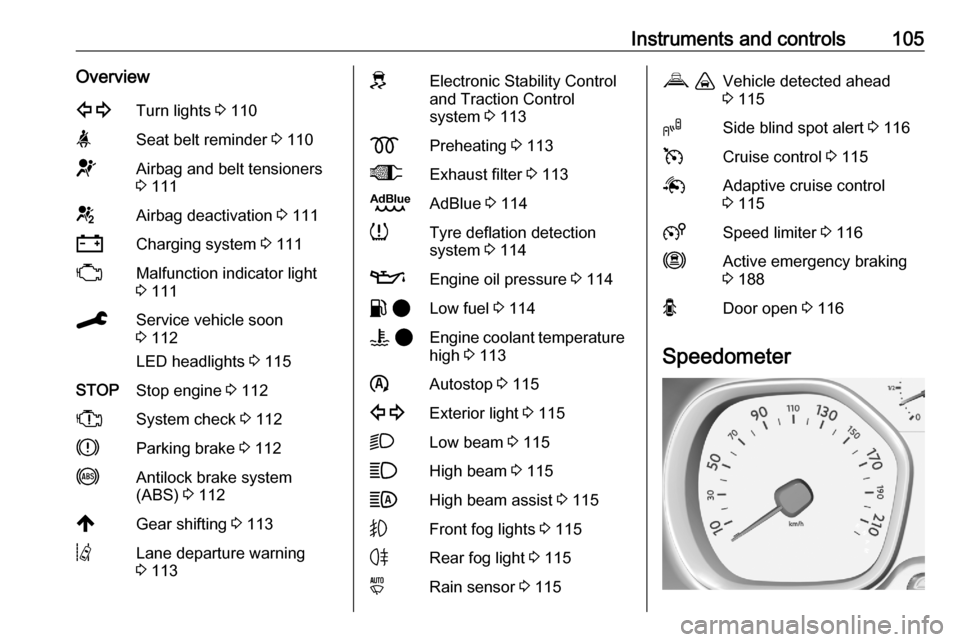
Instruments and controls105Overview1Turn lights 3 110aSeat belt reminder 3 110dAirbag and belt tensioners
3 111eAirbag deactivation 3 111SCharging system 3 111WMalfunction indicator light
3 111CService vehicle soon
3 112
LED headlights 3 115STOPStop engine 3 112XSystem check 3 112hParking brake 3 112iAntilock brake system
(ABS) 3 112,Gear shifting 3 113QLane departure warning
3 113JElectronic Stability Control
and Traction Control
system 3 113zPreheating 3 113+Exhaust filter 3 113BAdBlue 3 114qTyre deflation detection
system 3 114TEngine oil pressure 3 114r 2Low fuel 3 114V 2Engine coolant temperature
high 3 113ñAutostop 3 1151Exterior light 3 115DLow beam 3 115AHigh beam 3 115BHigh beam assist 3 115GFront fog lights 3 115HRear fog light 3 115yRain sensor 3 115V ,Vehicle detected ahead
3 115,Side blind spot alert 3 116vCruise control 3 115QAdaptive cruise control
3 1155Speed limiter 3 116mActive emergency braking
3 188ODoor open 3 116
Speedometer
Page 109 of 287
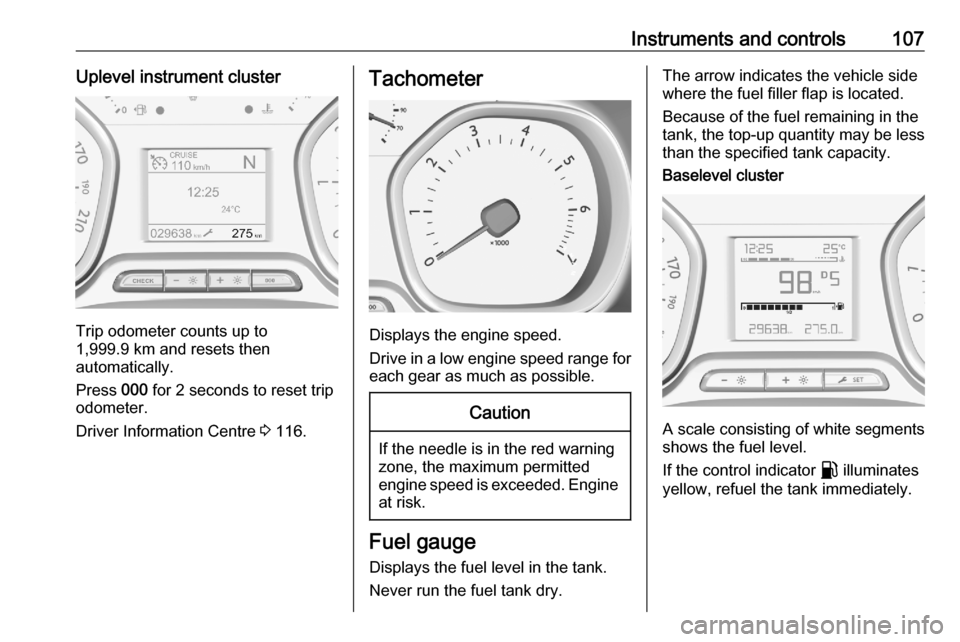
Instruments and controls107Uplevel instrument cluster
Trip odometer counts up to
1,999.9 km and resets then
automatically.
Press 000 for 2 seconds to reset trip
odometer.
Driver Information Centre 3 116.
Tachometer
Displays the engine speed.
Drive in a low engine speed range for each gear as much as possible.
Caution
If the needle is in the red warning
zone, the maximum permitted
engine speed is exceeded. Engine at risk.
Fuel gauge
Displays the fuel level in the tank.
Never run the fuel tank dry.
The arrow indicates the vehicle side
where the fuel filler flap is located.
Because of the fuel remaining in the
tank, the top-up quantity may be less
than the specified tank capacity.Baselevel cluster
A scale consisting of white segments
shows the fuel level.
If the control indicator r illuminates
yellow, refuel the tank immediately.
Page 110 of 287
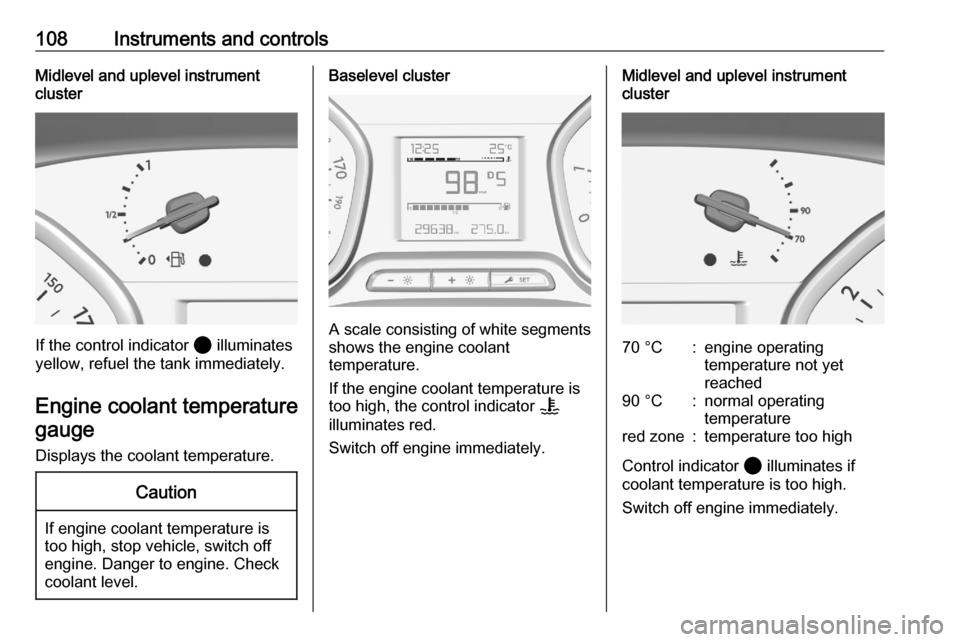
108Instruments and controlsMidlevel and uplevel instrument
cluster
If the control indicator 2 illuminates
yellow, refuel the tank immediately.
Engine coolant temperature gauge
Displays the coolant temperature.
Caution
If engine coolant temperature is
too high, stop vehicle, switch off
engine. Danger to engine. Check
coolant level.
Baselevel cluster
A scale consisting of white segments
shows the engine coolant
temperature.
If the engine coolant temperature is
too high, the control indicator V
illuminates red.
Switch off engine immediately.
Midlevel and uplevel instrument
cluster70 °C:engine operating
temperature not yet
reached90 °C:normal operating
temperaturered zone:temperature too high
Control indicator 2 illuminates if
coolant temperature is too high.
Switch off engine immediately.